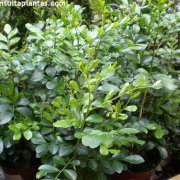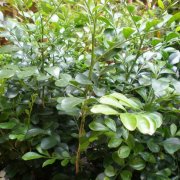Care of the shrub Murraya paniculata or Jasmine orange |
|
The genus Murraya, family Rutaceae, comprises 12 species of trees and shrubs native to China and Southeast Asia. Some species are: Murraya paniculata, Murraya koenigii, Murraya alata, Murraya stenocarpa, Murraya microphylla. Common names: Lakeview jasmine, Jasmine orange, Chinese box, Orange jessamine, Mock orange. This species is native to Asia and Australia. They are evergreen shrubs of compact size and aromatic bark that reach 7 meters (22.9 feet) in height. The leaves are shiny, have a slight aroma and are oval, elliptical or rhomboid in shape. They produce white flowers, softly scented and grouped in terminal racemes. They bloom in mid-summer but can do so almost all year round. The orange or red fruits are very decorative. Jasmine orange is used to form hedges, in pots (they bloom much less) for terraces and balconies and as a houseplant (in well-lit location) and as bonsai. Murraya paniculata needs full sun or semi-shade exposure and a Mediterranean, tropical or subtropical climate. It does not resist frost. The soil must be well drained and contain plenty of organic matter. The transplant is done in spring. Water abundantly during the summer; reduce watering the rest of the year in such a way that the substrate does not dry out completely (never flood). Fertilize in early spring with compost or manure. Prune in early spring to control growth and maintain a compact appearance. Orange jessamine is a plant prone to attack by aphids, whiteflies and mealybugs. Murraya paniculata is propagated from seed sown in spring or by cuttings in late summer. |
Images of the shrub Murraya paniculata or Jasmine orange |
Find plants
Murraya paniculata or Jasmine orange | Care and Growing
© 2025 FavThemes


